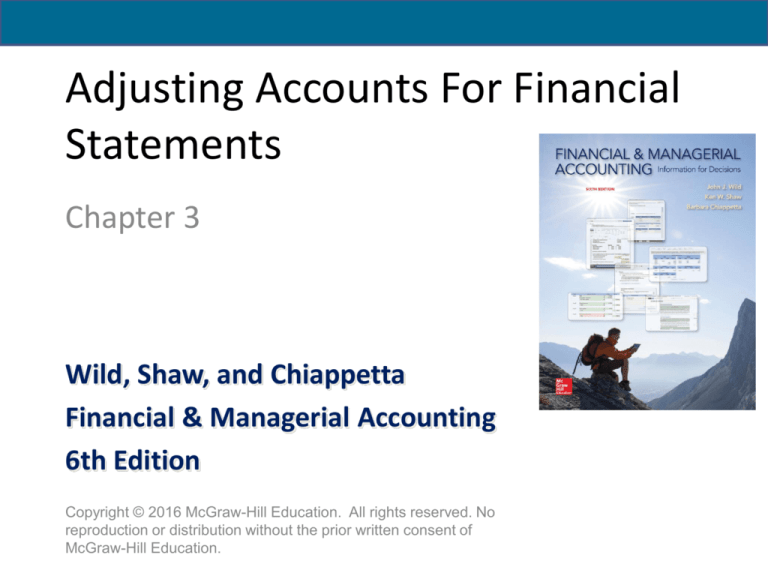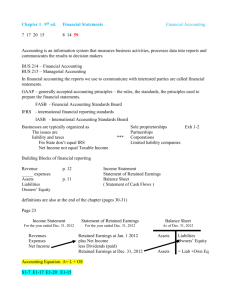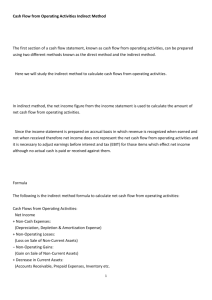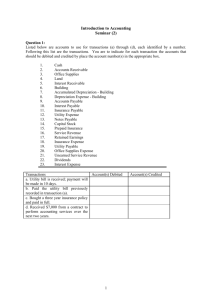
Adjusting Accounts For Financial
Statements
Chapter 3
Wild, Shaw, and Chiappetta
Financial & Managerial Accounting
6th Edition
Copyright © 2016 McGraw-Hill Education. All rights reserved. No
reproduction or distribution without the prior written consent of
McGraw-Hill Education.
The Accounting Period
C1
2
Accrual Basis versus Cash Basis
C1
Accrual Basis
Cash Basis
Revenues are
recognized when
earned and expenses
are recognized when
incurred.
Revenues are
recognized when cash
is received and
expenses are recorded
when cash is paid.
3
Accrual Basis versus Cash Basis
Accrual Basis
Cash Basis
Revenues are
recognized when
earned and expenses
are recognized when
incurred.
Revenues are
recognized when cash
is received and
expenses are recorded
when cash is paid.
Non-GAAP
C1
4
Accrual Basis versus Cash Basis
On December 1, 2015, FastForward paid $2,400
cash for a twenty-four month business insurance
policy.
C1
Using the cash basis, the entire $2,400 would be
recognized as insurance expense in 2015. No
insurance expense from this policy would be
recognized in 2016 or 2017, periods covered by
the policy.
5
Accrual Basis versus Cash Basis
On the accrual basis, $100 of insurance
expense is recognized in 2015, $1,200 in
2016, and $1,100 in 2017. The expense is
matched with the periods benefited by the
insurance coverage.
C1
6
Recognizing Revenues
The revenue recognition principle states
that we recognize revenue when the
product or service is delivered to our
customer.
C1
7
Recognizing Expenses
The expense recognition (or matching)
principle aims to record expenses in the
same accounting period as the revenues
that are earned as a result of those
expenses. This matching of expenses with
the revenue benefits is a major part of the
adjusting process.
C1
8
Framework for Adjustments
An adjusting entry is made at the end of an accounting
period to reflect a transaction or event that is not yet
recorded.
P1
9
Prepaid (Deferred) Expenses
(ex. Prepaid Insurance, Prepaid Rent, Supplies, etc.
Resources paid for
prior to receiving the
actual benefits.
P1
10
PREPAID INSURANCE
On December 1, 2015, FastForward paid $2,400 to cover
insurance for 24 months that began on December 1 of
2015. Scott recorded the expenditure as Prepaid
Insurance on December 1.
PREPAID INSURANCE
24-month policy
Beginning 12/01
P1
$2,400
11
PREPAID INSURANCE
PREPAID INSURANCE
$2,400
INSURANCE EXPENSE
$100
$100
$2,400/24 months = $100
Insurance Expense is debited
$100 to recognize the amount
of insurance coverage for Dec. and
Prepaid Insurance is credited for $100
to reduce it’s balance.
P1
12
PREPAID INSURANCE
(Balance Sheet)
PREPAID INSURANCE
$2,400
(Income Statement)
INSURANCE EXPENSE
adj $100
$100 adj
Bal.
$2,300
The Balance Sheet will show
$2,300 (23 months) of
Prepaid Insurance remaining!
P1
The Income Statement will
show $100 (1 month) of
insurance expired!
13
Adjusting Journal entry for Insurance
expired:
We’ve seen the adjustment in the T-accounts but we
need to record the adjustment on Dec. 31, in the
General Journal. . .
Insurance Expense
Dec. 1
2,400 Dec. 31
Bal.
2,300
637
100
Prepaid Insurance
Dec. 31
100
Dec. 31 Insurance Expense
Prepaid Insurance
128
100
100
To record first month's expired insurance
P1
14
Another adjusting entry which needs to be
made is for Depreciation
Instead of expensing the cost of a plant asset
(equipment, building, cars, etc.) in the year it is
purchased we allocate or spread out the cost over
their expected useful lives.
The formula for straight-line depreciation is:
Straight-Line
Asset Cost - Salvage Value
Depreciation =
Useful Life
Expense
P1
15
USEFUL LIFE
The period of time that an asset is expected
to help produce revenues.
Useful life expires as a result of wear and
tear, or because it no longer satisfies the
needs of the business.
P1
16
SALVAGE VALUE
• The expected market value or selling price
of an asset at the end of its useful life
• Also called:
– Scrap Value or
– Residual Value
P1
17
DEPRECIATION EXAMPLE
FastForward purchased equipment on Dec 1 for
$26,000. It has an estimated useful live of 60 months.
The equipment is expected to be worth about $8,000 at
the end of five years. They purchased the equipment
on Dec 1 but it is now Dec 31.
Because FastForward expects the equipment
to be worth $8,000 when the five years
are over, only $18,000 of the cost needs
to be spread over the next 60 months.
P1
18
STRAIGHT-LINE METHOD
1st step: Calculate Net Cost (the amount to
depreciate).
FORMULA:
Original
Cost
$26,000
P1
Salvage
Value
=
$8,000
=
Net Cost
$18,000
19
Calculating Depreciation Expense
2nd step: Determine depreciation expense
for this accounting period (one month).
FORMULA:
Net Cost
Estimated
Useful Life
P1
$18,000
60 mos.
$300 per
month
Now that we know depreciation for
the month is $300, let’s figure out the
adjusting entry. . .
20
Depreciation adjustment reflected in
our T-accounts looks like this:
Depreciation Expense
Equipment
12/1 26,000
12/31 300
Accumulated Depreciation
12/31 300
The depreciation amount of
$300 is credited to this
account instead of the
asset account.
21
Let’ look at the journal entry for the
adjustment for Depreciation..
Equipment
12/1 26,000
Depreciation Expense
12/31 300
Accumulated Depreciation-Equipment
12/31 300
Dec. 31 Depreciation Expense
Accumulated Depreciation - Equipment
P1
300
300
To record monthly equipment depreciation
22
Depreciation would show up on our
balance sheet like this:
FastForward
Partial Balance Sheet
At February 28, 2016
$
Assets
Cash
.
Equipment
Less: accumulated deprec.
.
.
Total Assets
P1
$ 26,000
(900)
25,100
After three
months of
depreciation
have been
taken, the
Equipment is
shown net of
accumulated
depreciation.
23
Unearned (Deferred)
Revenues
Cash received in
advance of providing
products or services.
P1
24
Accrued Expenses
Costs incurred in a
period that are
both unpaid and
unrecorded.
P1
25
NEED-TO-KNOW
Salaries Payable. At year-end, salaries expense of $5,000 has been incurred by the company, but is
not yet paid to employees.
Step 1: Determine what the current account balance equals.
Step 2: Determine what the current account balance should equal.
Salaries Payable
Unadj.
Adjustment
Dec. 31
$0
$5,000
0
5,000
5,000
Step 3: Record an adjusting entry to get from step 1 to step 2.
Date
Dec. 31
General Journal
Salaries Expense
Salaries Payable
Income Statement
Revenue
Debit Expense
P1
Debit
5,000
Credit
5,000
Balance Sheet
Asset
Credit Liability
26
NEED-TO-KNOW
Interest Payable. At its December 31 year-end, the company holds a mortgage payable that has
incurred $1,000 in annual interest that is neither recorded nor paid. The company intends to pay the
interest on January 3 of the next year.
Step 1: Determine what the current account balance equals.
Step 2: Determine what the current account balance should equal.
Interest Payable
Unadj.
Adjustment
Dec. 31
$0
$1,000
0
1,000
1,000
Step 3: Record an adjusting entry to get from step 1 to step 2.
Date
Dec. 31
General Journal
Interest Expense
Interest Payable
Income Statement
Revenue
Debit Expense
P1
Debit
1,000
Credit
1,000
Balance Sheet
Asset
Credit Liability
27
Accrued Revenues
Revenues earned in a
period that
are both unrecorded
and not yet received.
P1
28
NEED-TO-KNOW
Accounts Receivable. At year-end, the company has completed services of $1,000 for a client, but
the client has not yet been billed for those services.
Step 1: Determine what the current account balance equals.
Step 2: Determine what the current account balance should equal.
$0
$1,000
Accounts Receivable
Unadj.
0
Adjustment
1,000
Dec. 31
1,000
Step 3: Record an adjusting entry to get from step 1 to step 2.
Date
Dec. 31
General Journal
Accounts Receivable
Services Revenue
Income Statement
Credit Revenue
Expense
P1
Debit
1,000
Credit
1,000
Balance Sheet
Debit Asset
Liability
29
NEED-TO-KNOW
Interest Receivable. At year-end, the company has earned, but not yet recorded, $500 of interest
earned from its investments in government bonds.
Step 1: Determine what the current account balance equals.
Step 2: Determine what the current account balance should equal.
Unadj.
Adjustment
Dec. 31
$0
$500
Interest Receivable
0
500
500
Step 3: Record an adjusting entry to get from step 1 to step 2.
Date
Dec. 31
General Journal
Interest Receivable
Interest Revenue
Income Statement
Credit Revenue
Expense
P1
Debit
500
Credit
500
Balance Sheet
Debit Asset
Liability
30
Links to Financial Statements
P1
31
Adjusted Trial Balance
P2
32
Preparing Financial Statements
from an Adjusted Trial Balance
Step 1— Prepare income statement using revenue and expense
accounts from trial balance.
Step 2—Prepare statement of retained earnings using retained
earnings and dividends from trial balance; and pull
net income from step 1.
Step 3—Prepare balance sheet using asset and liability account
from trial balance; and pull updated retained earnings
balance from step 2.
Step 4—Prepare statement of cash flows from changes in cash
flows for the period (illustrated later in the book).
P3
33
Debit
Credit
Magic Company
Adjusted Trial Balance
December 31, 2015
Debit
Credit
Cash
$13,000
Accounts receivable
17,000
Land
85,000
Accounts payable
$12,000
Long-term notes payable
33,000
30,000
Common Stock
Retained Earnings
45,000
Dividends
20,000
Fees earned
79,000
Salaries expense
56,000
Office supplies expense
8,000
Totals
$199,000 $199,000
Magic Company
Income Statement
For Year Ended December 31, 2015
Fees earned
$79,000
Expenses
Salaries expense
$56,000
Office supplies expense 8,000
64,000
Net income
$15,000
Magic Company
Statement of Owner’s Equity
For Year Ended December 31, 2015
Retained Earnings, Dec. 31 2014
$45,000
Plus: Net income
15,000
Less: Dividends
(20,000)
Retained Earnings, Dec. 31 2015
$40,000
Magic Company
Balance Sheet
December 31, 2015
Assets
Cash
Accounts receivable
Land
P3
Total assets
$13,000
17,000
85,000
$115,000
Liabilities
Accounts payable
Long-term notes payable
Total liabilities
Equity
Common Stock
Retained Earnings
Total Equity
Total liabilities and equity
$12,000
33,000
45,000
Balance
Sheet
30,000
40,000
70,000
115,000
34
Recording Closing Entries
Close Credit Balances in
Revenue Accounts to Income
Summary.
Close Debit Balances in
Expense accounts to Income
Summary.
Close Income Summary
account to Retained Earnings.
Close Dividends to Retained
Earnings.
P4
35
Debit
$13,000
17,000
85,000
Cash
Accounts receivable
Land
Accounts payable
Long-term notes payable
Common stock
Retained earnings
Dividends
20,000
Fees earned
Salaries expense
56,000
Office supplies expense
8,000
Totals
$199,000
Date
Dec. 31
Dec. 31
Dec. 31
Dec. 31
P4
Credit
Expenses
Closing
$12,000
33,000
30,000
45,000
Income summary
64,000
Revenues
Net income
15,000
79,000
15,000
0
Retained earnings
12/31/2014
20,000 Net income
12/31/2015
Dividends
79,000
45,000
15,000
40,000
$199,000
General Journal
Fees earned
Income summary
Debit
79,000
Credit
79,000
Income summary
Salaries expense
Office supplies expense
64,000
Income summary
Retained earnings
15,000
Retained earnings
Dividends
20,000
56,000
8,000
15,000
20,000
36
Debit
$13,000
17,000
85,000
Cash
Accounts receivable
Land
Accounts payable
Long-term notes payable
Common Stock
Retained earnings
Totals
$115,000
Credit
Expenses
Closing
$12,000
33,000
30,000
40,000
$115,000
Income Summary
64,000
Revenues
Net income
15,000
79,000
15,000
0
Dividends
Retained Earnings
12/31/2014
20,000 Net income
12/31/2015
45,000
15,000
40,000
Magic Company
Balance Sheet
December 31, 2015
Assets
Cash
Accounts receivable
Land
Total assets
P4
$13,000
17,000
85,000
$115,000
Liabilities
Accounts payable
Long-term notes payable
Total liabilities
Equity
$12,000
33,000
45,000
Common stock
Retained earnings
Total equity
Total liabilities and equity
30,000
40,000
75,000
115,000
37
Post-Closing Trial Balance
List of permanent
accounts and their
balances after posting
closing entries.
Total debits and credits
must be equal.
P5
38
Post-Closing Trial Balance
P5
39
Accounting Cycle
C2
40
Classified Balance Sheet
Current items are those expected to come due (both
collected and owed) within the longer of one year or
the company’s normal operating cycle.
C3
41
Current Assets
Current assets are expected to be sold,
collected, or used within one year or the
company’s operating cycle.
C3
42
Long-Term Investments
Long-term investments are expected to be held for
more than one year or the operating cycle.
C3
43
Plant Assets
Plant assets are tangible long-lived assets used to
produce or sell products and services.
C3
44
Intangible Assets
Intangible assets are long-term resources used to
produce or sell products and services and that
lack physical form.
C3
45
Current Liabilities
Current liabilities are obligations due within the longer of
one year or the company’s operating cycle.
C3
46
Long-Term Liabilities
Long-term liabilities are obligations not due within
the longer of one year or the company’s operating
cycle.
C3
47
Equity
Equity is the owner’s claim on the assets.
C3
48
NEED-TO-KNOW
Use the adjusted trial balance of Magic Company to prepare its classified balance sheet as of
December 31, 2015.
Magic
Company
Magic
Company
Adjusted
Trial Balance
Adjusted
Trial
Adjusted
Trial Balance
Balance
December
31, 20X2
December
31,
December 31, 20X2
2015
Debit
Credit
DebitDebit Credit
Credit
Cash
$13,000
Accounts receivable
17,000
Land
85,000
Accounts payable
$12,000
Long-term notes payable
33,000
30,000
Common Stock
Retained Earnings
Dividends
Fees earned
45,000
20,000
79,000
Salaries expense
Trial Balance 56,000
Office supplies expense
8,000
Totals
C3
$199,000
Debit $199,000
Credit
Magic Company
Balance Sheet
December 31, 2015
Assets
Current assets
Cash
Accounts receivable
Total current assets
Plant assets
Land
Total plant assets
Total assets
Liabilities
Current liabilities
Accounts payable
Total current liabilities
Long-term liabilities
Long-term notes payable
Total liabilities
Equity
Common Stock
Retained Earnings
Total equity
Total liabilities and equity
$13,000
17,000
30,000
85,000
85,000
$115,000
$12,000
12,000
33,000
$45,000
30,000
40,000
70,000
$115,000
49
Global View
The definition of an asset is similar under U.S. GAAP and IFRS and
involves three basic criteria:
(1) the company owns or controls the right to use the item,
(2) the right arises from a past transaction or event, and
(3) the item can be reliably measured.
Both systems define the initial asset value as historical cost for
nearly all assets.
The definition of a liability is similar under U.S. GAAP and IFRS and
involves three basic criteria:
(1) the item is a present obligation requiring a probable future resource
outlay,
(2) the obligation arises from a past transaction or event, and
(3) the obligation can be reliably measured.
50
Global View
Both U.S. GAAP and IFRS include similar guidance for adjusting accounts. Although
some variations exist in revenue and expense recognition.
51
Profit Margin
The profit margin ratio measures the company’s net
income to net sales.
Profit
Net Income
=
Margin
Net Sales
Limited Brands, Inc.
A1
52
Benefits of a Work Sheet
Aids the
preparation of
financial
statements.
Reduces
possibility of
errors.
Links accounts
and their
adjustments.
P7
Assists in
planning and
organizing an
audit.
Not a
required
report.
Helps in
preparing
interim financial
statements.
Shows the
effects of
proposed
transactions.
53
NEED-TO-KNOW
The following 10-column work sheet contains the year-end unadjusted trial balance for Sampson Company
as of December 31, 2016. Complete the work sheet by entering the necessary adjustments, computing the adjusted
account balances, extending the adjusted balances into the appropriate financial statement columns, and entering
the amount of net income for the period. Note: The common stock account balance was $32,000 at December 31, 2015.
Unadjusted
Trial Balance
No.
Dr.
Cr.
101 Cash
23,000
106 Accounts receivable
8,000
183 Land
52,000
201 Accounts payable
10,000
251 Long-term notes payable
43,000
301 Common Stock
32,000
302 Dividends
10,000
401 Fees earned
70,000
622 Salaries expense
54,000
650 Office supplies expense
8,000
Totals
155,000 155,000
Adjustments
Dr.
Cr.
Adjusted
Trial Balance
Dr.
Cr.
Income
Statement
Dr.
Cr.
Balance Sheet
and Statement of
Ret. Earnings
1. Prepare and complete the work sheet, starting with the unadjusted trial balance and including adjustments
based on the following.
a. The company has earned $9,000 in fees that were not yet recorded at year-end.
b. The company incurred $2,000 in salary expense that was not yet recorded at year-end.
(Hint: For simplicity, assume it records any salary not yet paid as part of accounts payable.)
c. The long-term note payable was issued on December 31 this year. Thus, no interest has yet accrued
on this loan.
P7
Dr.
Cr.
54
Unadjusted
Adjusted
Trial Balance
Trial Balance
Adjustments
No.
Dr.
Cr.
Dr.
Cr.
Dr.
Cr.
101 Cash
23,000
23,000
106 Accounts receivable
8,000
(a) 9,000
17,000
183 Land
52,000
52,000
201 Accounts payable
10,000
(b) 2,000
12,000
251 Long-term notes payable
43,000
43,000
301 Common Stock
32,000
32,000
302 Dividends
10,000
10,000
401 Fees earned
70,000
(a) 9,000
79,000
622 Salaries expense
54,000
(b) 2,000
56,000
650 Office supplies expense
8,000
8,000
Totals
155,000 155,000
11,000
11,000 166,000 166,000
Net income
Totals
Income
Statement
Dr.
Cr.
Balance Sheet
and Statement of
Owner's Equity
Dr.
Cr.
23,000
17,000
52,000
12,000
43,000
32,000
10,000
79,000
56,000
8,000
64,000
15,000
79,000
79,000 102,000
87,000
15,000
79,000 102,000 102,000
a. The company has earned $9,000 in fees that were not yet recorded at year-end.
b. The company incurred $2,000 in salary expense that was not yet recorded at year-end.
(Hint: For simplicity, assume it records any salary not yet paid as part of accounts payable.)
c. The long-term note payable was issued on December 31 this year. Thus, no interest has yet accrued
on this loan.
P7
55
Unadjusted
Adjusted
Trial Balance
Trial Balance
Adjustments
No.
Dr.
Cr.
Dr.
Cr.
Dr.
Cr.
101 Cash
23,000
23,000
106 Accounts receivable
8,000
(a) 9,000
17,000
183 Land
52,000
52,000
201 Accounts payable
10,000
(b) 2,000
12,000
251 Long-term notes payable
43,000
43,000
301 Common Stock
32,000
32,000
302 Dividends
10,000
10,000
401 Fees earned
70,000
(a) 9,000
79,000
622 Salaries expense
54,000
(b) 2,000
56,000
650 Office supplies expense
8,000
8,000
Totals
155,000 155,000
11,000
11,000 166,000 166,000
Net income
Totals
Income
Statement
Dr.
Cr.
Balance Sheet
and Statement of
Ret. Earnings
Dr.
Cr.
23,000
17,000
52,000
12,000
43,000
32,000
10,000
79,000
56,000
8,000
64,000
15,000
79,000
79,000 102,000
87,000
15,000
79,000 102,000 102,000
2. Use information from the completed work sheet in part 1 to prepare adjusting entries.
Date
General Journal
Dec. 31 Accounts Receivable
Debit
9,000
Fees earned
Dec. 31 Salaries expense
Accounts payable
Credit
9,000
2,000
2,000
Dec. 31 No journal entry required
P7
56
3. Prepare the income statement and the statement of retained earnings for the year ended December 31 and
the unclassified balance sheet at December 31.
Debit
$23,000
17,000
52,000
Cash
Accounts receivable
Land
Accounts payable
Long-term notes payable
Common Stock
Dividends
10,000
Fees earned
Salaries expense
56,000
Office supplies expense
8,000
Totals
$166,000
Credit
$12,000
43,000
32,000
79,000
$166,000
Sampson Company
Income Statement
For Year Ended December 31, 2016
Fees earned
$79,000
Expenses
Salaries expense
$56,000
Office supplies expense 8,000
64,000
Net income
$15,000
Sampson Company
Statement of Retained Earnings
For Year Ended December 31, 2016
Retained Earnings, Dec. 31 2015
$
00
Plus: Net income
15,000
Less: Dividends
(10,000)
Retained Earnings, Dec. 31 2016
$ 5,000
Sampson Company
Balance Sheet
December 31, 2016
Assets
Cash
Accounts receivable
Land
P7
Total assets
$23,000
17,000
52,000
$92,000
Liabilities
Accounts payable
Long-term notes payable
Total liabilities
Equity
Common Stock
Retained Earnings
Total liabilities and equity
$12,000
43,000
55,000
32,000
5,000
92,000
57









